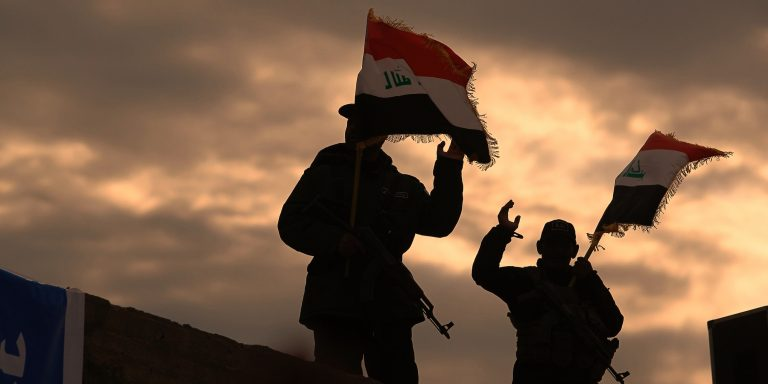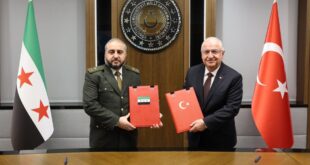
Attacks by Iraqi militia, backed by Iran, on protesters and activists are destabilizing Iraq in the run-up to October 2021 national elections.
The government of Prime Minister Mustafa al-Kadhimi is attempting to marginalize the Iran-backed militias, but only enjoying mixed success.
The militias suppress any challenge to their autonomy, their linkages to Iran, or their control over economic assets and patronage networks.
Iran supports Iraqi Shia militias in order to exert influence in Iraq and achieve leverage over the United States.
Eighteen years after the U.S.-led invasion that toppled the regime of Saddam Hussein, Iraq is still struggling to achieve stability and consolidate the authority of its national government. The overthrow of the Sunni Arab-led Ba’athist regime empowered Shia politicians, many of whom had been long allied with the Islamic Republic of Iran. These political leaders fostered the formation of several Shia-dominated militias nominally under state command, but which are armed and advised by Iran’s Islamic Revolutionary Guard Corps (IRGC). The militias have become spearheads for Iranian influence in Iraq, acting as leverage against U.S. personnel in Iraq, and for supporting Iran’s efforts to dominate Iraq’s economy. The commanders of several of the militias have become major political actors that influence decision-making and provide patronage to their supporters in the form of government jobs and contracts, control of enterprises and import-export channels, and social benefits.
The militias have also sought to suppress a popular protest movement that began in October 2019, in part as a backlash against the stranglehold that Iran and its Iraqi proxies maintain over large parts of Iraq’s economy. The protests eventually forced then-Prime Minister Hayder Al Abadi to resign. His successor, Prime Minister Mustafa al-Kadhimi, who faces a national election battle in October 2021, has sought to hold militias accountable for abuses of activists as part of his efforts to marginalize them outright. However, the militias, and their backers in Tehran, have not bowed to the will of either Kadhimi or the protest movement. The militias allegedly have targeted – including through killings, kidnappings, and other forms of intimidation—more than 70 activists since the protest movement began.
In the latest power struggle between Kadhimi and the militias, the Iraqi government arrested pro-Iranian militia commander Qasem Muslih for the May 9 killing of activist Ihab al-Wazni in the southern city of Karbala. Wazni, a vocal critic of Iraqi armed groups and of Iranian influence in Iraq, led protests in his home city, where pro-Tehran armed groups hold considerable sway. His death sparked day-long protests in Karbala that saw demonstrators block roads and bridges and set fire to Iran’s consulate in the city. In an effort to intimidate the government to release Muslih, Shia militia fighters encircled Baghdad’s heavily fortified Green Zone, where foreign embassies and the government’s top headquarters are located. In contrast to a similar incident in July 2020, in which Shia militias succeeded in obtaining the release of an accused militia commander, the government has held Muslih in a facility partially secured by U.S. and NATO forces and has refused to release him. Still, amid tepid backing from senior Iraqi political leaders reluctant to risk a rift with Tehran or its armed Iraqi proxies, in early June Kadhimi threatened to resign unless the government gives him a free hand to confront the militias and bring them under his authority.
The confrontations between Kadhimi and the Iran-backed militias underscore the degree to which Iran seeks to use Iraq to carry out its national security policies. Iran has armed its Iraqi militia allies with sophisticated rockets, short-range ballistic missiles, and drones with which they continue to attack not only bases where U.S. forces operate, but also the U.S. Embassy in Baghdad and reportedly a facility for the Central Intelligence Agency, and installations of U.S. companies. The attacks are central to Iran’s efforts to drive the remaining 2,500 U.S. military personnel out of Iraq and to avenge the Trump administration’s strike that killed IRGC-Qods Force commander Qasem Soleimani in Baghdad in January 2020.
By providing financial and political support to pro-Iranian candidates in Iraq’s October 10 election, Iran is also likely to try to engineer the replacement of Kadhimi with a more pliant and less pro-American Prime Minister. It remains an open question whether the Biden administration will devote the resources needed to help Kadhimi challenge Tehran’s influence. Senior U.S. officials, eyeing a deal with Tehran on a mutual return to the 2015 multilateral Iran nuclear agreement, reportedly have overruled those U.S. officials who have sought U.S. retaliation against the Iran-backed militias for some of their recent attacks on U.S. installations in Iraq. Not only does the Biden administration want to reorient U.S. policy broadly away from the Middle East, but it also is intent on discontinuing the previous administration’s proxy war against Iran on Iraqi soil.
 Eurasia Press & News
Eurasia Press & News



